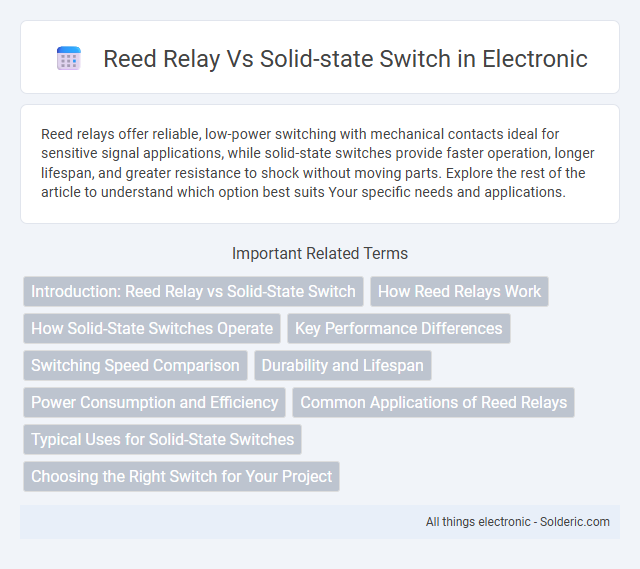Reed relays offer reliable, low-power switching with mechanical contacts ideal for sensitive signal applications, while solid-state switches provide faster operation, longer lifespan, and greater resistance to shock without moving parts. Explore the rest of the article to understand which option best suits Your specific needs and applications.
Comparison Table
| Feature | Reed Relay | Solid-State Switch |
|---|---|---|
| Operation | Electromagnetic mechanical switch | Semiconductor-based electronic switch |
| Switching Speed | 1-3 ms | Microseconds to nanoseconds |
| Contact Life | 1 billion cycles approx. | 100 billion+ cycles |
| Signal Distortion | Minimal, low noise | Potential for signal distortion |
| Voltage and Current Ratings | Up to 200 V and 2 A typical | Lower voltage and current ratings, often < 100 V and < 1 A |
| Off-State Leakage | Near zero | Higher leakage currents |
| Size | Generally larger due to coil and reed structure | Compact, integrated circuits |
| Power Consumption | Requires coil drive current | Very low power, often logic-level driven |
| Cost | Moderate to high | Generally lower cost |
| Applications | High isolation, low signal distortion, test equipment | High-speed switching, low power applications, digital circuits |
Introduction: Reed Relay vs Solid-State Switch
Reed relays utilize magnetic fields to open and close contacts, providing excellent isolation and low contact resistance ideal for sensitive signal switching. Solid-state switches rely on semiconductor devices such as MOSFETs or TRIACs, offering faster switching speeds, longer lifespans, and enhanced durability without mechanical wear. Both components serve distinct roles in electronic circuits, with reed relays favored for precision and solid-state switches preferred for high-speed, high-cycle applications.
How Reed Relays Work
Reed relays operate by using a pair of ferromagnetic reeds sealed within a glass tube that close or open an electrical circuit when exposed to a magnetic field generated by a coil. When current flows through the coil, the magnetic field causes the reeds to attract and make contact, providing a physical connection with low resistance and high isolation. Your choice between a reed relay and a solid-state switch depends on the need for mechanical isolation, switching speed, and signal integrity in specific applications.
How Solid-State Switches Operate
Solid-state switches operate by using semiconductor devices such as transistors, thyristors, or MOSFETs to control the flow of electrical current without mechanical movement. These switches rely on electronic signals to rapidly open or close circuits, offering high-speed switching and enhanced durability compared to reed relays. The absence of physical contacts reduces wear and enables solid-state switches to perform reliably in high-frequency and high-precision applications.
Key Performance Differences
Reed relays provide excellent isolation and low contact resistance, making them ideal for precision switching applications, while solid-state switches offer faster switching speeds and higher reliability with no mechanical wear. Reed relays typically handle lower power levels but excel in sensitive signal paths due to minimal signal distortion, whereas solid-state switches support higher frequencies and longer lifetimes under harsh conditions. The choice depends on the application requirements for signal integrity, switching speed, and durability.
Switching Speed Comparison
Reed relays typically operate with switching speeds in the range of 0.5 to 2 milliseconds, providing a reliable mechanical contact closure ideal for low-frequency signals. Solid-state switches offer significantly faster switching times, often in the microsecond range, enabling high-speed signal routing without mechanical wear or arcing. Your choice between these components depends on whether ultra-fast switching or mechanical isolation is more critical for your application.
Durability and Lifespan
Reed relays offer exceptional durability with mechanical lifespans typically exceeding 10^9 operations, making them reliable for low-level signal switching in sensitive applications. Solid-state switches, while lacking moving parts and thus immune to mechanical wear, often face limitations from semiconductor degradation and thermal stress, which can reduce their operational lifespan under high-voltage or high-temperature conditions. Careful selection based on environmental factors and switching requirements is essential to maximize longevity in both technologies.
Power Consumption and Efficiency
Reed relays exhibit low power consumption during operation as they primarily require energy only to switch states, making them highly efficient for intermittent use. Solid-state switches consume continuous power to maintain conduction, which can result in higher energy usage in prolonged applications. Efficiency in reed relays is enhanced by minimal coil power draw, while solid-state devices offer faster switching speeds but often at the cost of increased power dissipation.
Common Applications of Reed Relays
Reed relays are commonly used in test and measurement equipment due to their fast switching and low contact resistance, ensuring precise signal integrity. These relays find application in telecommunications for switching low-level signals and in medical devices where reliable isolation and signal fidelity are critical. Their ability to operate in high-frequency RF circuits and withstand harsh environmental conditions makes them ideal for aerospace and military communication systems.
Typical Uses for Solid-State Switches
Solid-state switches are commonly used in applications requiring fast switching speeds and high reliability, such as telecommunications, medical devices, and automated test equipment. These switches excel in environments where silent operation, long lifetime, and low power consumption are crucial. Your choice of solid-state switches can enhance performance in sensitive signal routing and precision measurement systems.
Choosing the Right Switch for Your Project
Choosing the right switch for your project depends on factors such as switching speed, power handling, and signal integrity. Reed relays offer excellent isolation and low contact resistance, making them ideal for precise analog signal switching, while solid-state switches provide faster switching speeds and longer lifespans without mechanical wear. Your selection should balance these characteristics based on the specific electrical and performance requirements of your application.
reed relay vs solid-state switch Infographic

 solderic.com
solderic.com